Amazon (NASDAQ:AMZN) has just cleared up the picture over its cloud computing business, Amazon Web Services (AWS) and the company’s forecast looks sunny. The corporation recently announced its first quarter earnings for 2015 and financial pundits were flabbergasted to see just how profitable AWS has been for Amazon, earning $5.16 billion in revenue over a recent 12-month period and growing at a rate of nearly 50 percent year-over-year. The service had already posted 1 million customers by November of last year. North American sales for the quarter increased by 24 percent to $13.4 billion.
Importantly, Amazon Web Services isn’t just making money, it’s also generating a hefty profit for the company. Barron’s has reported that, although AWS only produces about 7 percent of Amazon’s revenues, it was the source of 37 percent of Amazon’s total profit. Retail sales account for 92 percent of Amazon’s revenue but only 49 percent of the company’s profit. Comparatively, AWS revenues are skyrocketing at 49 percent growth in the past quarter, compared to Amazon’s overall revenue growth of 15 percent. This quarterly report is Amazon’s first to include AWS as a reportable segment, finally lifting the veil on a business program the corporation has been developing since 2006. After a string of rough financial returns in recent years, Amazon’s decision to finally lift the veil on AWS prompted enough investor confidence that share prices jumped as high as 16 percent after the announcement.
One important takeaway from this is that a person would be pretty mistaken to assume that Amazon is still solely an online retailer. That’s still the bulk of their business, but it’s not the company’s strongest investment. If the cloud computing industry continues to grow at the incredible pace which it has, Amazon may very well have found itself a strong foothold in the high tech market and the way that they’re doing it is great for small businesses that cannot make heavy investments into information technology.
What makes cloud computing so valuable is the way that it can be scaled effectively to a customer’s needs, allowing Amazon to make a profit on small businesses and big corporate alike. AWS customers range from tiny business operations trying to market a service over the Internet for the first time to online behemoths such as Netflix. For just about every company that uses digital technologies, save for some exceptions where a company has developed its own computing resources, it will be more cost effective to outsource to Amazon’s IT services instead of maintain in-house IT.
[Companies-1]
Cloud computing has three major components: Infrastructure as a Service (IaaS); Platform as a Service (PaaS); and Software as a Service (SaaS). One popular and useful metaphor which has been used before to explain the cloud computing market compares the Internet to the American interstate system. The roads are the infrastructure on which every product can be carried, much like the data servers and networks that make up IaaS. The vehicles which transport the valuable goods and people across the country makes up the platform and PaaS technologies enable cloud-based coding and application deployment. Those valuable goods and people can be thought of as the SaaS component of cloud computing, the applications that people download to their smartphones or tablets.
Amazon’s financial disclosure on AWS comes amidst a growing chorus of optimism in the profitability of the cloud computing sector. Global spending for cloud computing services made up only 4 percent of all IT expenditures but financial analysts predict that the cloud computing market will grow from $176 billion this year up to $240 billion in 2017. The valuation for Amazon Web Services has been pegged at $44 billion which, as The Economist article linked here points out, approaches the entire market capitalization of major IT firms like Hewlett-Packard ($59.80 billion as of this writing). Amazon makes up 28 percent of the cloud computing market, trailed by Microsoft (10 percent), IBM (7 percent) and Google (5 percent). IBM has reported one-year revenues for cloud technologies of $7.7 billion, Microsoft reporting $6.3 billion but Business Insider recently argued that IBM and Microsoft’s actual “as a Service” cloud offerings earnings were $3.8 billion annually and $1 billion lifetime, respectively. Unless Google has been hiding a tremendously valuable cloud business in the $7 billion “Other” segment of its most recent earnings report, Amazon’s $5.16 billion take makes it the leader of the pack.
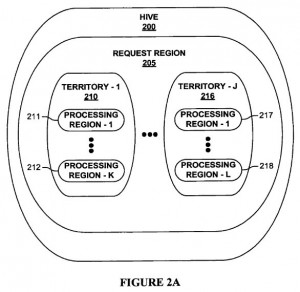 Our readers should be pretty interested to know that Amazon is currently disputing two allegations of wrongful patent infringement filed in U.S. district courts over its AWS business. St. Louis-based cloud computing startup Appistry is accusing Amazon of infringing two patents which were the topic of discussions between Appistry and Amazon officials between August and September of 2004. U.S. Patent No. 8200746, titled System and Method for Territory-Based Processing of Information, claims an information processing system comprised of a plurality of networked hive engines grouped into a plurality of territories, the hive engines configured to receive processing job requests. The distribution of processing jobs within particular territories is advantageous for the reliability and performance of cloud processing; Amazon boasts AWS’s ability to deploy apps
Our readers should be pretty interested to know that Amazon is currently disputing two allegations of wrongful patent infringement filed in U.S. district courts over its AWS business. St. Louis-based cloud computing startup Appistry is accusing Amazon of infringing two patents which were the topic of discussions between Appistry and Amazon officials between August and September of 2004. U.S. Patent No. 8200746, titled System and Method for Territory-Based Processing of Information, claims an information processing system comprised of a plurality of networked hive engines grouped into a plurality of territories, the hive engines configured to receive processing job requests. The distribution of processing jobs within particular territories is advantageous for the reliability and performance of cloud processing; Amazon boasts AWS’s ability to deploy apps 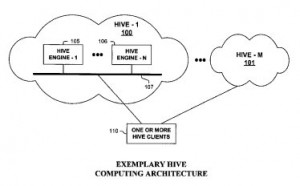 internationally in minutes. Another system for processing information which also involves hive computing is disclosed by U.S. Patent No. 8341209, titled System and Method for Processing Information Via Networked Computers Including Request Handlers, Process Handlers, and Task Handlers. This innovation also provides a reliable computing framework and platform with improved performance at a lower cost. Both of these patents were issued to Appistry in 2012. No troll here.
internationally in minutes. Another system for processing information which also involves hive computing is disclosed by U.S. Patent No. 8341209, titled System and Method for Processing Information Via Networked Computers Including Request Handlers, Process Handlers, and Task Handlers. This innovation also provides a reliable computing framework and platform with improved performance at a lower cost. Both of these patents were issued to Appistry in 2012. No troll here.
Amazon is also facing suit from ZitoVault, LLC, over a patent related to AWS’s Elastic Compute Cloud and Virtual Private Cloud products, among other Amazon cloud offerings. U.S. Patent No. 6484257, titled System and 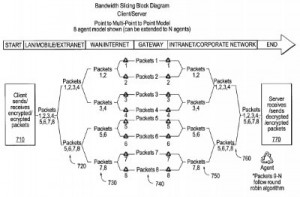 Method for Maintaining N Number of Simultaneous Cryptographic Sessions Using a Distributed Computing Environment. Issued to solo inventor Alonzo Ellis of San Jose, CA, in November 2002, the patent claims a software architecture for conducting a plurality of cryptographic sessions over a distributed computing environment. The software was designed to address the major computational issues of providing secure communication. ZitoVault itself markets a couple of cloud-based services for secure payment transactions, mobile applications and cloud security, so this suit would seem to pass the patent troll sniff test as well.
Method for Maintaining N Number of Simultaneous Cryptographic Sessions Using a Distributed Computing Environment. Issued to solo inventor Alonzo Ellis of San Jose, CA, in November 2002, the patent claims a software architecture for conducting a plurality of cryptographic sessions over a distributed computing environment. The software was designed to address the major computational issues of providing secure communication. ZitoVault itself markets a couple of cloud-based services for secure payment transactions, mobile applications and cloud security, so this suit would seem to pass the patent troll sniff test as well.
Also of interest is the fact that, on first glance, Amazon doesn’t seem to have the strongest IP portfolio in the world of cloud computing. A search of cloud computing technologies using Innography’s patent analysis tools turns up 55 U.S. patents held by the company. That’s certainly a fair amount, but it’s only the fourth-largest portfolio trailing behind IBM (367 U.S. patents), Microsoft (158 U.S. patents) and Red Hat Inc. (58 U.S. patents). It’s also tied with Google’s 55 cloud computing patents.
[Companies-2]
We decided to take a closer look at some of these patents to get an idea of what kind of Internet services Amazon has earned the right to protect. U.S. Patent No. 8296434, titled Providing Dynamically Scaling Computing Load Balancing, claims a computer-readable medium that is executed to provide load balancing functionality to a multitude of computing nodes. The dynamic expansion and shrinking of the quantity of computing nodes based on factors such as monetary cost or environmental cost. This innovation is designed to remove some of the complexity 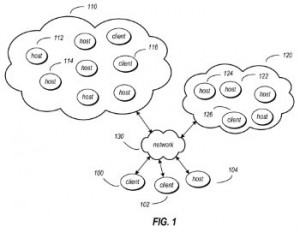 associated with provisioning, administering and managing the physical computing resources of data centers. A similar kind of decentralized IaaS cloud computing technology is at the center of U.S. Patent No. 8707194, entitled System and Method for Decentralized Performance Monitoring of Host Systems. The patent claims a computer system containing a memory storing instructions executable by a processor to implement performance monitoring of multiple host systems by collecting and aggregating data from different host systems. This technology is intended to determine the quality of service received by a consumer of a cloud service, supporting the on-demand provisioning of computer resource infrastructure to relieve the lead time for consumer installation and configuration of services.
associated with provisioning, administering and managing the physical computing resources of data centers. A similar kind of decentralized IaaS cloud computing technology is at the center of U.S. Patent No. 8707194, entitled System and Method for Decentralized Performance Monitoring of Host Systems. The patent claims a computer system containing a memory storing instructions executable by a processor to implement performance monitoring of multiple host systems by collecting and aggregating data from different host systems. This technology is intended to determine the quality of service received by a consumer of a cloud service, supporting the on-demand provisioning of computer resource infrastructure to relieve the lead time for consumer installation and configuration of services.
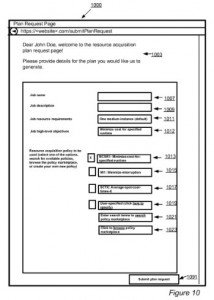 A technology which seems to span infrastructure (IaaS) and platform (PaaS) services is reflected within U.S. Patent No. 8898763, which is titled Automated Infrastructure Operations. The method protected here involves receiving a request from a service owner for the provisioning of infrastructure operations, determining computing resources to support the computing service based in part on a forecasted operation of a computing service and creating a number of custom alarms that monitor the execution of the computing service. This method of automating a portion of the infrastructure operations has been designed for the easier deployment of a computing service with reduced errors and delays. The complexity of cloud computing services is also on display in U.S. Patent No. 8676622, entitled Job Resource Planner for Cloud Computing Environments. The patent protects a system wherein one or more computing devices are configured to implement a resource planner. The planner receives a request involving a job goal and an amount of resources to require. The planner generates a resource acquisition plan based on an analysis of pricing data. This technology is designed to enable more dynamic pricing options that can be made available to AWS consumers based on supply and demand of resources.
A technology which seems to span infrastructure (IaaS) and platform (PaaS) services is reflected within U.S. Patent No. 8898763, which is titled Automated Infrastructure Operations. The method protected here involves receiving a request from a service owner for the provisioning of infrastructure operations, determining computing resources to support the computing service based in part on a forecasted operation of a computing service and creating a number of custom alarms that monitor the execution of the computing service. This method of automating a portion of the infrastructure operations has been designed for the easier deployment of a computing service with reduced errors and delays. The complexity of cloud computing services is also on display in U.S. Patent No. 8676622, entitled Job Resource Planner for Cloud Computing Environments. The patent protects a system wherein one or more computing devices are configured to implement a resource planner. The planner receives a request involving a job goal and an amount of resources to require. The planner generates a resource acquisition plan based on an analysis of pricing data. This technology is designed to enable more dynamic pricing options that can be made available to AWS consumers based on supply and demand of resources.

![[IPWatchdog Logo]](https://ipwatchdog.com/wp-content/themes/IPWatchdog%20-%202023/assets/images/temp/logo-small@2x.png)

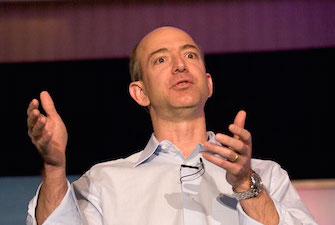
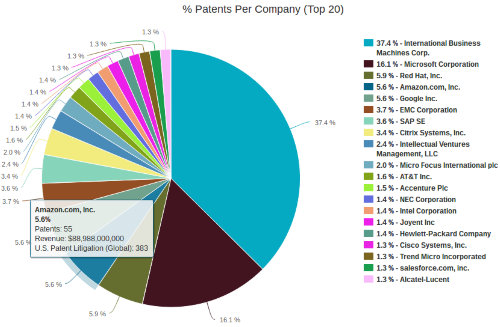
![[Advertisement]](https://ipwatchdog.com/wp-content/uploads/2024/04/Patent-Litigation-Masters-2024-sidebar-early-bird-ends-Apr-21-last-chance-700x500-1.jpg)

![[Advertisement]](https://ipwatchdog.com/wp-content/uploads/2021/12/WEBINAR-336-x-280-px.png)
![[Advertisement]](https://ipwatchdog.com/wp-content/uploads/2021/12/2021-Patent-Practice-on-Demand-recorded-Feb-2021-336-x-280.jpg)
![[Advertisement]](https://ipwatchdog.com/wp-content/uploads/2021/12/Ad-4-The-Invent-Patent-System™.png)







Join the Discussion
2 comments so far.
Amnon M Cohen
May 2, 2015 06:20 amThis shows, how simple it was made, to make money from a simple system of delivering a service — employing computers and smart-cell-phones.
Good pioneering work, grants healthy profits and reasonable costs = modern economic growth.
Night Writer
May 1, 2015 11:34 amThis is just a great article! Thanks for putting all this together.